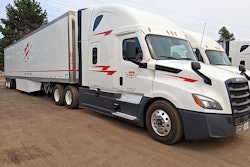Penske Truck Leasing has improved technician productivity by using a diagnostics platform from Nexiq Technologies. After plugging a wireless device into the truck, technicians can troubleshoot engines and other components from a stationary PC.
Technicians at Penske Truck Leasing’s 670 service centers use a stationary PC to troubleshoot the company’s very large, diverse fleet. A small wireless device plugged into a vehicle’s data port links it instantly to a PC loaded with various diagnostics software tools.
“If the shop has six half bays, all full, a technician can plug a device into a truck in the yard and start troubleshooting,” says Mike Hasinec, Penske’s vice president of maintenance systems and support.
Besides boosting technician productivity, the diagnostics platform from Nexiq Technologies lets Penske centrally update its diagnostics applications from all locations instantly through the Internet, Hasinec says.
Not all fleets agree that vehicle diagnostics can be so simple. Vehicle electronics are increasing in complexity. Troubleshooting and repair equipment requires continuous training and software upgrades for engines, transmissions, brakes and other components. “The problem has just gotten worse,” says Steph Sabo, maintenance manager of Norrenberns Truck Service, a 170-truck carrier based in Nashville, Ill.
But staying current with technology is worth the cost and effort, Sabo says, considering the alternative – the cost and downtime to outsource diagnostics and repair. To address this complexity, leading providers of fleet maintenance technology are making diagnostics information more accessible, automated and integrated with daily operations.
Managing separate systems
One of the difficulties of troubleshooting today’s vehicles is deciphering the volumes of information they generate. As with most computerized systems, vehicles use a set of standard protocols to communicate information among the different components – engines, brakes, dash gauges, etc. – in a network environment. Heavy-duty vehicles (Class 4-8) use the J1708 and J1939 serial-data protocols from the Society of Automotive Engineers (SAE), whereas passenger and work vehicles (Class 1-3) use the OBD-II standard.
In addition to SAE standards, heavy-duty vehicle and component manufacturers use many proprietary codes in order to protect their intellectual property and maintain tight control over their systems’ settings and parameters.
“Everybody has their own protocol,” says Kevin Tomlinson, chairman of the Technology and Maintenance Council’s (TMC) study group on onboard electronics. And original equipment manufacturers (OEMs) don’t necessarily want to give up their proprietary information, says Tomlinson, who also is director of maintenance for South Shore Transportation Co., a 200-truck carrier based in Sandusky, Ohio. “Everybody doesn’t always play together well,” he says. “It makes it hard for the end user.”
As an example of how much data on a vehicle is proprietary, consider the standard J1708 fault code message. A fault code has four parts: a message identifier (MID), a parameter indicator (PID), a system identifier (SID) and a failure mode indicator (FMI) that shows the severity of the fault code.
The standard fault codes from the vehicles’ J1708 and J1939 channels (MID numbers 128 through 256) are easy to interpret, since SAE defines and publishes them. About 50 percent (MID numbers 0 through 127) are proprietary, says Charles Stannard, product manager of PeopleNet’s Fault Codes offering. PeopleNet recently introduced Fault Codes as an application in its mobile fleet management system to allow customers to monitor J1708 and J1939 fault codes remotely.
To decipher proprietary codes, fleets often use software supplied by manufacturers of engines, transmissions, brakes, truck bodies and other vehicle components that allows them to diagnose problems, change settings and fully use data generated by those components and systems. In most cases, this supplier software provides the only applications that can interpret proprietary fault codes and change system settings and parameters, such as idle RPM or top speed, Tomlinson says.
Lancaster, Pa.-based Venezia Bulk Transport uses three separate PC software programs within its 400-truck fleet: Caterpillar’s Electronic Technician, Volvo’s VCADS Pro and Cummins’ Insight.
“All the OEMs are great,” says J.P. Venezia, warranty and systems manager. “Some send an updated CD every three months. Volvo software is updated via the Internet. We are not having any issues with updating our software.” Besides being relatively easy to maintain, manufacturers’ software generally has become much easier to use. “You don’t even have to be computer-literate,” Venezia says.
Ideally, Venezia would like all manufacturers to use one platform to read the electronic control modules (ECMs), as is the case with passenger vehicles and the OBD-II standard. “That would make it a lot easier,” he says.
Independent vendors of diagnostics technology claim an advantage of being able to offer all-in-one diagnostics solutions that can eliminate the need to use separate OEM software applications – and thus not have to toggle between different programs on a laptop or PC.
Noregon Systems’ latest version of J-Pro provides one-screen visibility to diagnose engine, transmission and brake problems, says Michael Kinney, director of fleet sales. J-Pro doesn’t provide the same level of detail as OEM software, but fleets can, at a minimum, tell immediately if a vehicle can be fixed in-house or if it should be taken to a dealership, Kinney says.
Noregon also provides OEM software to customers that request additional drill-down capabilities, such as the ability to reprogram settings. The company can add OEM software to the PC-based version of J-Pro, and Noregon also can manage all upgrades and new releases from OEMs, Kinney says.
As electronics and telematics advance, truck and component manufacturers also have made diagnostics more accessible to the driver. Understanding vehicle fault codes has become simpler, with manufacturers incorporating a digital dash display in the instrument cluster, says Kirk Altricher, vice president of maintenance for Gordon Trucking in Pacific, Wash.
Current and future dash displays translate most engine and vehicle fault codes into a readable format, thus eliminating the need to hook up a scan tool or a PC to the truck. Drivers can be alerted to fault codes – along with a description – to make it easier to communicate with fleet managers and outside repair shops, Altricher says.
Remote diagnostics
When electronic diesel engines became standard in the mid-1990s, fleet managers could diagnose problems by connecting a scan tool or PC to a vehicle. This was a great leap forward, but as technology advanced, so did fleet expectations. A driver could see a “service engine” and other indicators in the cab, but days – and even weeks – might pass before fleet management could assess problems and route vehicles to a service center.
“What happened in the past is you didn’t always get good information,” says Walter Cornwell, director of maintenance for R.E. Garrison, a 350-truck fleet based in Cullman, Ala.
Telematics has solved this problem at R.E. Garrison and many other carriers. Powerful onboard computers and high-speed networks now provide continuous monitoring and reporting of the vehicle’s performance and condition.
All of the largest providers of onboard computing and mobile communications for truckload and LTL operations offer remote monitoring applications of fault codes that appear in the J1708 and J1939 networks. They also capture many other aspects of vehicle and driver performance data in a vehicle’s ECM.
About 12 years ago, Qualcomm Wireless Business Solutions offered a remote vehicle monitoring product called JTracs Pro with its OmniTracs system for real-time management of vehicle data, including fault codes and other J1708 data.
Two years ago, R.E. Garrison began using ADV Monitor, a performance reporting feature of GeoLogic’s multimode communications and tracking system. Being able to see fault codes in the office as soon as they appear in a vehicle “lets us know if we need to get it straight into a shop or do something else,” Cornwell says. “It helps us make a decision.”
In February, PeopleNet added Fault Codes to its PerformX vehicle monitoring solution. Customers can set up tables to define what fault codes they want to see (by MID and PID indicator) and how frequently they want to report each type of fault code – from once a day to real time. Users can view fault codes through PeopleNet’s Web-based user interface and through instant e-mail alerts, Stannard says. PeopleNet also offers OBD-II to extend PerformX capabilities to light trucks, vans and automobiles.
Another relatively new telematics system, Eaton’s Fleet Resource Manager – developed through an alliance between Eaton Corp. and @Road Inc. – includes an Advanced Diagnostics Package that not only reports a fault code, but also provides operating information surrounding it. When a fault condition occurs, the system automatically records and transmits 41 seconds of critical incident-related data using a new Rolling Freeze technology, Eaton says. It also provides real-time notifications that can be received in the office or field.
Telematics offerings also are beginning to include maintenance services. Networkcar recently joined with GE Motor Club to enhance its emergency roadside assistance services.
Incremental automation
Even with real-time information on vehicle condition, some fleet managers want telematics to accomplish more. Telematics solutions can alert fleet managers to a problem automatically, but managers still must actively schedule resources to fix the problem. And they often must investigate root causes for problems that show up as fault codes.
“We need to find ways to fully automate the redundant processes of managing a fleet,” says Charles Arsenault, president of Arsenault Associates, which provides the Dossier fleet maintenance management system. Information such as vehicle mileages, hours and fault codes can be imported automatically into Dossier to schedule maintenance.
Arsenault Associates has developed a solution to integrate advanced telematics features with its fleet maintenance system. When an onboard computing and mobile communications system reports an exception – such as a vehicle fault code or drop in fuel mileage – the exception is downloaded into Dossier immediately, Arsenault says. Work processes can be created for each exception, depending on the level of value or immediacy assigned to it.
Fleets also are asking for the ability to capture and integrate fault codes into their maintenance planning systems. Imagine that as a truck cruises the interstate or enters a terminal gate, a telematics solution using wide-area communications or local-area networks such as 802.11 or RFID automatically creates a work-pending order for a fault code.
“I think we are at that point,” says Rick Rosenberg, president of TMT Software. “It has been talked about for years as something that should be done. I’d be surprised if next year at this time it’s not done or in the process.”
Fleets also can tie electronic payment systems into real-time fleet maintenance. If an engine fault code warrants an immediate repair, a fleet manager would know the location of a truck via GPS. He then could search for the closest vendor in the Dossier system based on the service issue. Once the service was complete, he could request a one-time MasterCard number from Comdata, for example, to pay the vendor – all from one software system, Arsenault says.
Rather than using multiple software systems to access repair diagrams, maintenance histories and other applicable repair information, Altricher envisions the day when technicians at Gordon Trucking will be able to pull a tractor or trailer into the shop, enter the unit ID number into one system, and get the applicable repair information immediately on the spot, including warranty items and repair diagrams.
“Today there are different sites we have to go to,” Altricher says.
Developers of fleet maintenance management systems are working to make this vision a reality. To incorporate repair information, fleets can create hyperlinks to OEM manuals or attach files to each equipment record with information such as specifications, parts and repair information, Arsenault says.
“This way, it is up to the user to decide how far he wants to go,” Arsenault says. Future generations of fleet maintenance software will introduce libraries and “smarts” to make it easy for users to find repair information in one system, he says.
As vehicles become more complex, the same doesn’t have to be true for managing the technology to diagnose and repair them.
The OEM advantage
Truck makers see competitive edge in telematics
The ultimate experts in how vehicle electronics and components operate are truck OEMs. Several also are touting their advantage in telematics for remote diagnostics. International Aware, first launched in 2004, is a Web-based telematics solution that has several unique diagnostics features, the company says. The system includes a service scheduler based on engine hours and odometer readings; it also has a fault code diagnostic feature that indicates when maintenance is needed.
International Aware not only reads fault codes from International Trucks, but also provides a description of what they mean in English by integrating with International’s ISIS troubleshooting guide, says Laura Graham, International’s senior analyst of telematics. The link can include a wiring diagram and other information associated with the repair.
ISIS includes repair and service information for International’s proprietary multiplexed electrical system, the Diamond Logic Electrical system. Diamond Logic includes multiplexed wiring, advanced diagnostics, truck-body integration software and auxiliary power sources.
In 2005, Volvo Trucks released VolvoLink Sentry for its 880 truck model. Rather than just report fault codes through its Volvo Link telematics solution, the company monitors fault codes that appear more than five minutes. With 24/7 support, a Volvo representative will contact the fleet or driver and recommend action – such as scheduling an appointment at a Volvo dealership and ordering a part in advance, says Don Philyaw, director of sales and marketing support.
As of October 2006, 2007 Volvo trucks with U.S. ’07 engines come standard with Volvo Link Sentry service, which includes two-way satellite communications and Volvo Action Service (VAS) 24/7 roadside assistance service.
Since releasing VolvoLink Sentry, the company has developed a filter for codes that do not require immediate attention, Philyaw says; for example, Volvo does not need to intervene the moment a low water code appears. But if the code shows up three times in the last month, Volvo could detect the possibility of a slow leak and contact the owner, Philyaw says.
Besides reporting fault codes, the VolvoLink service allows fleet owners to track and monitor fuel usage, stability control interventions and traction control for hard braking incidents.
This fall, sister company Mack Trucks plans to offer its RoadConnect telematics solution as a factory-installed option, says Jerry Warmkessel, the company’s marketing product manager for highway products. Next year, Mack plans to provide a remote monitoring service where fault codes can be sent automatically to a Mack call center, Warmkessel says. (For more on OEM telematics, see “The Virtual Truck,” CCJ, December 2006.)










